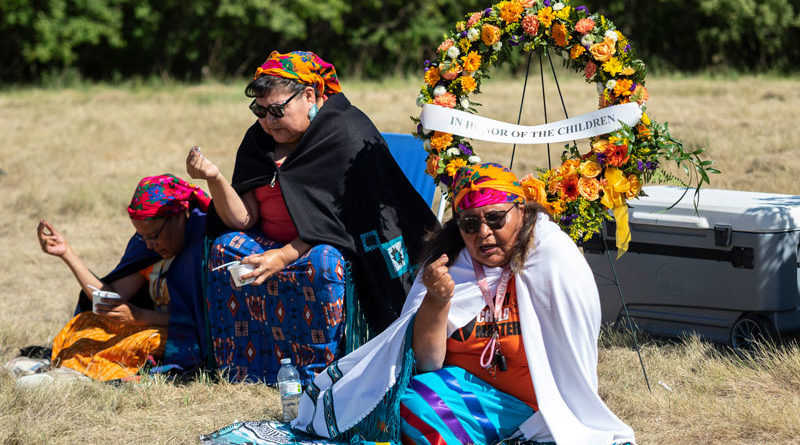Siksika hosts ceremonies and convoy
By John Watson Local Journalism Initiative Reporter

John Watson Photo
As a way to honour the lives of those who attended residential schools, ceremonies were held at two former school sites in Siksika territory on July 1.
To what Chief Ouray Crowfoot said would be the first of many similar ceremonies, the purpose is to start the healing process from the deaths at the former residential schools.
“With any process you [have] to start off acknowledging it and starting the healing process. [The] events had nothing to do with locating bodies, doing any kind of ground-penetrating radar, none of that,” he said.
“That work is going to take place, but [the event] was about awareness, bringing the community together, acknowledgement, doing some blessings … then we heard some stories from some of the survivors who went through that school.”
The July 1 event was held first at the site of what used to be the Crowfoot residential school, followed by a convoy that marched to the site of the Old Sun school.
Crowfoot noted there were four similar school sites in Siksika territory, but two of which were called agency schools, which predated the residential school system.
He said when the residential schools were still active, everyone who attended was afflicted by their experiences.
“Everybody who went to these schools saw something they shouldn’t have seen; went through things they shouldn’t have went through,” said Crowfoot. “It was a genocide. There’s no way to say it other than a genocide, from a cultural aspect as well as a physical aspect.”
During the ceremonies, elders who survived the system shared their stories and their experiences from the institutions.
Crowfoot added both of his parents were survivors of the residential school system.
“One of the survivors told a story, his mom gave birth to his sister, and they took her from birth. This guy’s 82 years old, he says every day he’s looking for his sister to come home,” he said. “One of my relatives told me he dug graves … a 13-year-old boy should not be digging graves. A 10-year-old girl should not be getting molested by somebody they see next to God.”
Of the 134 residential schools that were operated in Canada between 1893 and 1996, 25 schools are recognized in Alberta through the Indian Residential Schools Settlement Agreement.
Strathmore Mayor Pat Fule, who also attended the ceremonies, said he was impressed at the optimism and the attitude of the First Nations speakers, as well as the tribal council leaders and chiefs.
“There was a looking back, a nod and a reference and a respect for what happened in the past, but there was also a lot of talk about, this was done by past Canadian governments, this was done by past Canadian churches,” said Fule. “We do honour and we don’t ever want this to be forgotten … but they also talked a lot in positive terms about moving forward.”
Crowfoot added he believed it to be a step in the right direction that many non-native people decided to attend the ceremonies and pay their respects.
“There were a lot of non-native people at the event and to me, that was a good sign of the bridges that we’re building with some of our communities,” said Crowfoot.
He added the traumas experienced through the residential school systems will take multiple generations to heal, and acknowledging the events that occurred is the first step of the process.
